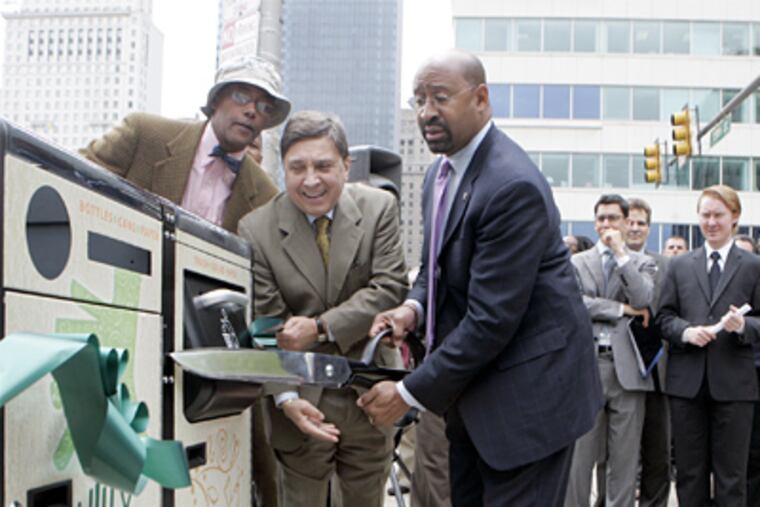New city trash bins are smart, green-friendly
It's big. It's brainy. Officials say it will save money. And it's solar-powered to boot. Philadelphia installed the first of a new generation of trash containers yesterday, and it had officials giddy with green. They all but hugged the thing as they posed with it and cut a big green ribbon tied around its middle.

It's big. It's brainy. Officials say it will save money. And it's solar-powered to boot.
Philadelphia installed the first of a new generation of trash containers yesterday, and it had officials giddy with green. They all but hugged the thing as they posed with it and cut a big green ribbon tied around its middle.
Called the BigBelly, the new can on the block - in this case, 15th Street and JFK Boulevard at JFK Plaza - has a solar panel that powers a trash compactor, allowing the bins to accept four to eight times as much waste before being full.
Instead of having to be emptied 19 times a week - like the current wire bins - the BigBellys are expected to hold out for more than a day and require emptying only five times a week, saving staff time, fuel costs, and greenhouse-gas emissions.
As the bins fill, a sensor will shift from green to yellow to red, and the BigBelly's wireless device will phone Streets Department headquarters with the news.
By July, 500 BigBelly "ecostations" are to be installed between South and Spring Garden Streets from the Schuylkill to the Delaware.
Of those, 210 will have companion recycling bins - marking the debut of on-street recycling in Center City. This, too, could produce savings because landfilling is more expensive than recycling.
"We're very excited," said Streets Commissioner Clarena W. Tolson. "We're saving taxpayer dollars."
Richard Kennelly, vice president of marketing for BigBelly Solar, in Needham, Mass, crunched some city numbers, coming up with $12.9 million in savings over 10 years.
The Center City litter baskets required 33 workers to empty, Tolson said; the BigBellys will need just eight. The others will shift jobs.
Mayor Nutter, clowning as he investigated the device, invited South Philadelphia resident Kelly Collins to be the first user and toss in his soda cup.
"See?" Nutter said, turning to beam at the small crowd that had assembled. "You don't need any instructions. Anybody can do it."
Meanwhile, officials bid good riddance to Center City's 700 wire litter baskets. They had overflowed too often. The trash had blown out. They had filled with rain and attracted rodents.
The BigBelly is supposed to solve those problems because it's enclosed. Sheet metal cloaked in heavy plastic, it is meant to last eight years.
It has withstood Midwestern floods, Canadian winters, and even young men and beer in Boston.
After the Celtics won the NBA championship last year, hoodlums managed to upend a BigBelly, but only because they dislodged the paver it remained bolted to.
Crews repositioned the Belly in time for the parade the next day, Kennelly said.
BigBelly compactors take trash in Baltimore's Inner Harbor, Chicago's Millennium Park, Boston's Fenway Park, and Walden Pond, now a tourist spot.
Philadelphia paid $2.2 million for its bins, but it used state money - funding awarded to municipalities based on recycling rates.
Philadelphia's rate has risen from 6 percent - once a national embarrassment - to 12 percent this year. Officials credit single-stream recycling, which became citywide in January.
The city's Greenworks plan, a sustainability road map announced Wednesday, calls for increasing the city's recycling rate to 70 percent by 2015. Nutter said the BigBelly could help the city get there.
Officials picked Center City to launch the program because it has the most pedestrians with the most trash.
The BigBelly has already been granted the official nod of Drexel University and the city housing authority.
Drexel purchased 11 last summer, and they worked so well that the university added five more in February. All but one have the companion recycling bins.
Since then, the university's recycling rate has increased 13 percent, and nearly a third of that is due to the BigBellys, said Mike Smith, director for facilities management.
Last spring, the housing authority installed 25 bins in nine developments.
With the old cans, said spokesman Kirk Dorn, litter was strewn on the ground around them. It either blew out or was the result of the common - and commonly failed - maneuver of "shooting" trash as if it were a basketball toward the container.
The BigBelly is "more inviting," Dorn said. "They encourage the residents to put the trash in."
After a one-year trial of a single BigBelly compactor, the University of Pennsylvania has installed 10 more in the last month, said Anne Papageorge, vice president for facilities.
She said she was unsure how to marry the look of the BigBelly with the stone-and-ivy aesthetic of Penn. So for now, the bins are in perimeter locations.
But when she heard Philadelphia's units had custom-designed panels, she perked up.
"We'll have to work on that," she said.